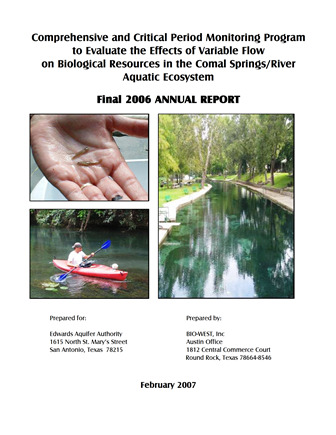Comprehensive and Critical Period Monitoring Program to Evaluate the Effects of Variable Flow on Biological Resources in the Comal Springs/River Aquatic Ecosystem Final 2006 Annual Report

| Summary |
|
The purpose of this report is to document the results of all aquatic ecosystem monitoring conducted in 2006 at Comal Springs located in New Braunfels, Texas. The monitoring and report preparation was performed by BIO-WEST, Inc. Pflugerville, Texas. [Excerpted from the Executive Summary] Aquatic vegetation in the four sample reaches was mapped twice in 2006 to better understand discharge to vegetation growth relationships, and the relationship between fountain darter (Etheostoma fonticola) populations and their habitat. Overall, growth in vegetation was variable among the sites during 2006. … Size-class distributions of fountain darters in reaches furthest removed from spring influence demonstrated that larger fountain darters were more abundant in fall, and smaller darters were more numerous in spring indicating a spring reproductive peak. In the reaches closer to spring influence, a second peak of small darters was also seen in fall indicating that year-round reproduction does occur in certain areas. Last year, an effort was made to establish a rapid method for assessing changes in fountain darter population abundance between sample efforts, especially during Critical Periods (high- and low-flow events). This dip-netting protocol was continued in 2006 at all four sites. In 2006, darters were found in 70% of dips across all vegetation types in the spring, and 60% in the fall. … [N]o live specimens [of giant ramshorn snails] were collected during 2006 sampling efforts. However, since these snails can have severe impacts at high densities, their populations will continue to be monitored and remain a key focus during critical low-flow periods. … All SCUBA/snorkel surveys revealed the presence of Comal Springs salamanders along the lake bottom and in each sampled Spring Run in 2006. Though lower than average discharge was present in 2006, salamander populations remained consistent in the spring runs. … A total of 144 hours of sample time occurred among the three drift net sites at Comal Springs in 2006 and 11 species were captured. Population changes of species in 2006 were similar to previous years. Species of the genus Stygobromus and Lirceolus continued to be most abundant at all sites. Stygobromus pecki (Peck’s cave amphipod) was the dominant amphipod … Initial observations of the gill parasite Heterophyid cercariae show that the Elizabeth Street site (Old Channel) has the highest abundance in the water column compared to the other two sites. In addition, concentrations of the parasite appeared to increase as discharge decreased. Since the intensive parasite evaluation began in 2006, there have been a total of thirteen rounds of parasite sampling, and an additional fifteen rounds will be completed before the study is completed in June 2007. … Overall, the most concerning observation in the Comal Springs / River ecosystem is that the Old Channel Reach is not nearly as productive as it had been during the early years of this study. |
Search for Documents
Advance Search
Explore EAA's Scientific Reports
- All Reports
- Modeling
- Hydrology and Hydrogeology
- History
- Groundwater Recharge, Recharge Zone
- Groundwater Movement
- Geomorphology and Caves
- Weather Modification
- Geology
- Water Use and Conservation
- Geochemistry
- Water Resources Planning and Management
- Floods and Drought
- Water Quality
- Climatology
- Surface Water / Groundwater Relationship
- Biology
- Springs, Groundwater Discharge
- Archaeology
- RZ Protection
- Aquifer Levels
- Remote Sensing
- Precipitation
- Overview Studies
